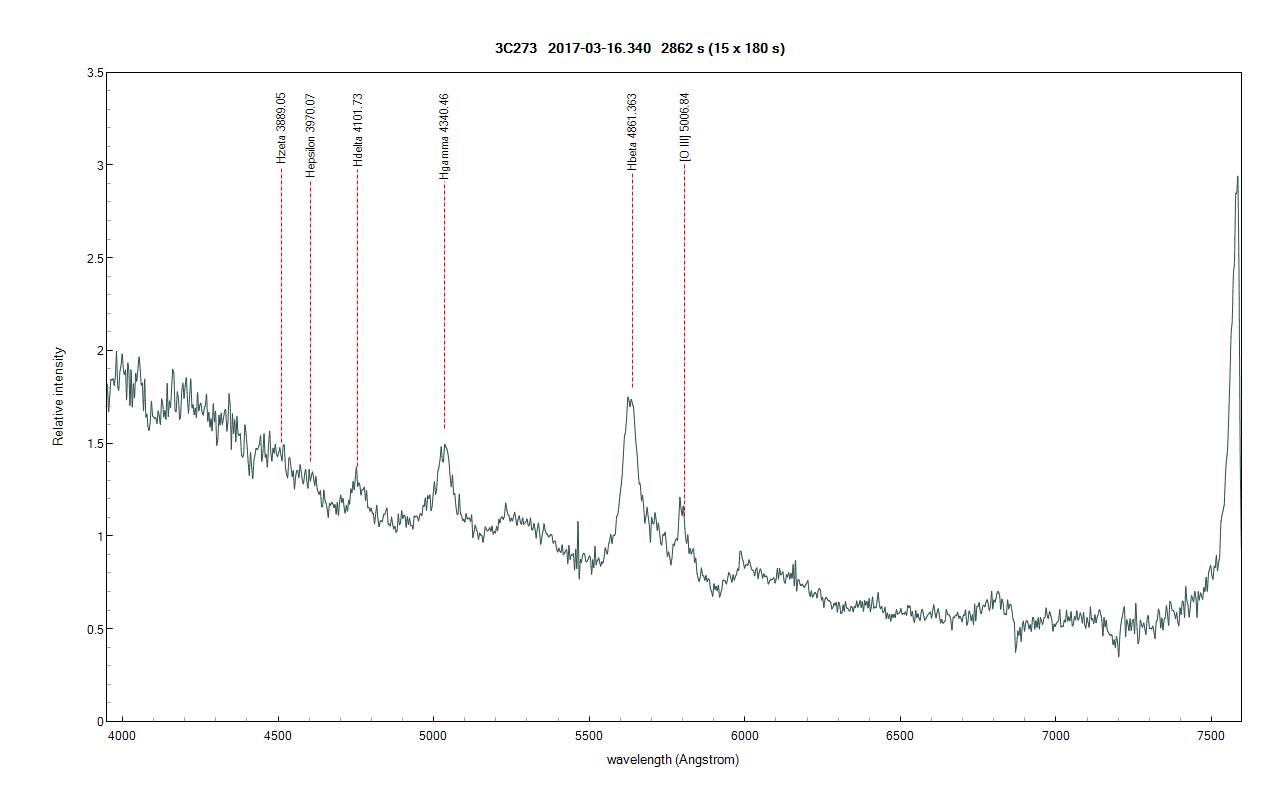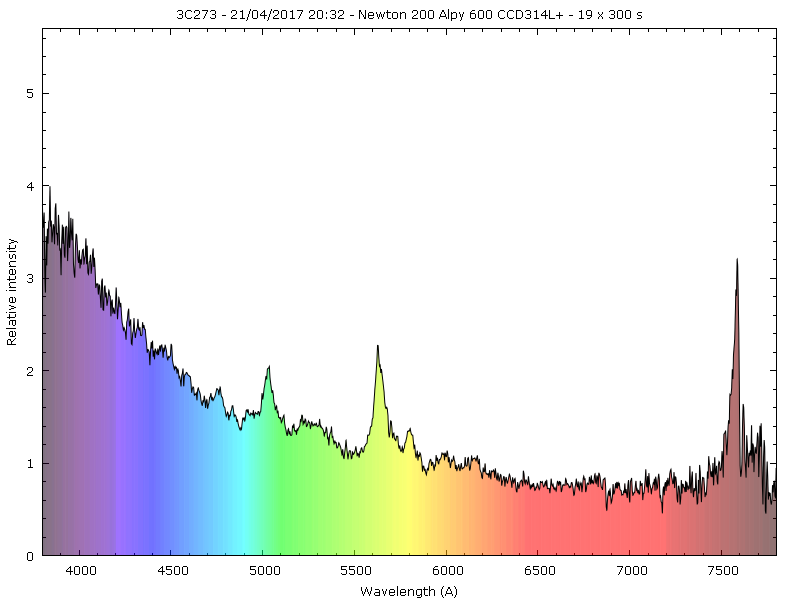Page 2 of 4
Re: 3C273 with Alpy600
Posted: Sun Apr 17, 2016 6:54 pm
by etienne bertrand
Thanks Robin,
Very good too, and congratulation for the SN2016bme !
Re: 3C273 with Alpy600
Posted: Tue Apr 19, 2016 6:20 pm
by Francois Teyssier
Bonjour Etienne,
Beau résultat !
La valeur que tu obtiens est celle qui est admise
Voir notemment :
http://cdsads.u-strasbg.fr/cgi-bin/nph- ... etcookie=1
Il s'agit de la mesure du décalage par rapport à longueur d'onde au repos (Doppler)
Il permet de calculer comme tu l'as fait la vitesse, 15% par rapport à la vitesse de la lumière.
15% n'est pas négigeable : il faut appliquer les corrections relativistes.
Si tu les négliges, tu obtiens un redshift de 0.158. C'est la valeur que l'on retrouve souvent, par erreur, par exemple sur wikipedia
Tu calcules la vitesse en km/s : v = Delta lambda/lambda * c avec c = 300 000 km/s
Tu utilises la formule relativiste : z+1 = racine ((c+v)/(c-v)
Et tu obtiens le redshit (0.173), la valeur indiquée par Simbad
Bonne continuation,
François
Note : les vitesses d'expansion des ejecta supernovae atteignant dans les premières phases des vitesses de l'ordre de 15000 km/s la correction relativiste commence à de venir significative.
Re: 3C273 with Alpy600
Posted: Wed Apr 20, 2016 12:08 pm
by etienne bertrand
Bonjour François,
Merci beaucoup pour ta réponse complète et tes explications. Je comprends mieux maintenant les différents résultats trouvés sur le net. Je vais refaire tous les calculs, c'est excellent.
Et dire que ces photons ont parcourus 2 milliards d'années pour atterrir sur le capteur ccd...
Re: 3C273 with Alpy600
Posted: Wed Apr 20, 2016 5:11 pm
by Martin Dubs
Hello Francois,
I think you and SIMBAD are wrong. Redshift z is defined as delta lambda/lambda(0) and Etienne , Robin, Richi Walker, Greenstein and almost everbody else obtains z=0.158 for 3C273. From this you can calculate the velocity either by the classical formula cz = 47500 km/sec, or by the relativistic formula, which gives v(rel) = c[(z+1)^2-1]/[(z+1)^2+1] = 43800 km/sec. As I pointed out above, the values given by Simbad somehow mixed up classical and relativistic velocities. The correct way is to start from the measured redshift and then calculate the velocities and not the other way round.
Please check again,
Regards, Martin
Re: 3C273 with Alpy600
Posted: Wed Apr 20, 2016 5:27 pm
by Robin Leadbeater
It is true that if you want to know calculate the velocity of an object from the Doppler shift you need to correct for relativistic effects but historically, cosmological redshift z is by definition just (lambda observed-lambda rest)/lambda rest, for example
https://ned.ipac.caltech.edu/help/zdef.html
so the value z =0.158 is the correct one to quote.
Strictly speaking, the redshift of 3c273 we observe is nothing to do relative velocity and Doppler shift. It is actually caused by the cosmological expansion of space which occurred between the emission of the photon and us observing it, according to the lamda CDM (big bang) theory.
Cheers
Robin
EDIT: Ha Ha I see Martin has posted while I was typing

also edited the formula (swapped observed and rest to give correct sign
Re: 3C273 with Alpy600
Posted: Tue May 24, 2016 10:07 pm
by etienne bertrand
Martin, for you, what is the good distance to 3c273 ?
- 677 MPc ?
- 749 Mpc ?
With V= 43800 Km/s and D = 677 Mpc the hubble constant = 64.7 Km/S/Mpc
With V= 43800 Km/s and D = 749 Mpc the hubble constant = 58.5 Km/s/Mpc
Re: 3C273 with Alpy600
Posted: Fri May 27, 2016 7:04 pm
by Martin Dubs
Hello Etienne,
The NASA database gives about 650 MPc for the distance, depending on what corrections you apply to the redshift.
https://ned.ipac.caltech.edu/cgi-bin/ob ... edValues_0
Look also at the details in the link above, which contains some explanations.
Th correct question is to ask what value they assume for the Hubble constant (73 +/- 5 km/sec/MPc), because you cannot calculate the Hubble constant from an object of unknown distance.
Regards, Martin
Re: 3C273 with Alpy600
Posted: Sat May 06, 2017 1:17 am
by James Foster
Here is my recent (16Mar17) spectrum of 3C 273 taken with the LISA spectroscope, Atik 460ex, and CDK17 F/6.8 reflector:

I used a value of 48,000 km/sec to make balmer line identities match with the features in 3C 273's red-shifted spectrum. That
intense spike between Hb and H-gamma is my light pollution Hg line! For the southern portion of the sky I was viewing 3C 273, there
are numerous old Mercury vapor lamps which reflecting off the light mist from the Pacific ocean, gives intense Hg lines in the LISA
spectra!
James
Re: 3C273 with Alpy600
Posted: Sat May 06, 2017 8:24 am
by etienne bertrand
Hello James,
Nice spectra !
And how much Redshift do you find ?
Re: 3C273 with Alpy600
Posted: Tue May 09, 2017 9:29 pm
by JP Nougayrede
Just another spectrum of this classic target, very fun to observe with the Alpy, even under orange skies.

- _3c273_20170421_856.png (42.4 KiB) Viewed 9007 times

- 3c273_vs_balmer_redshift.png (61.27 KiB) Viewed 9007 times
Bon ciel à tous,
Jean-Philippe
